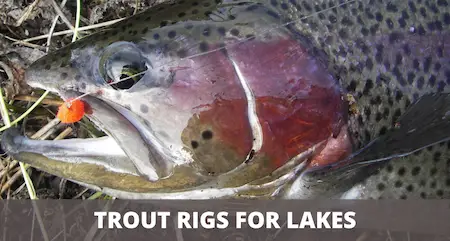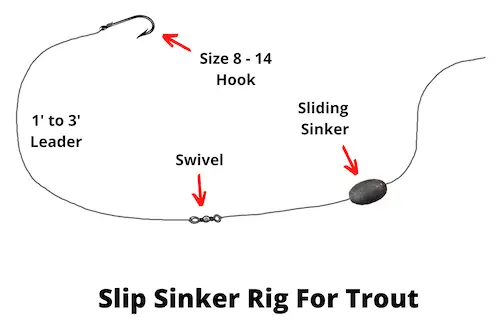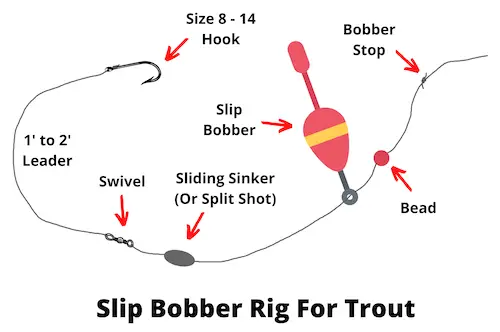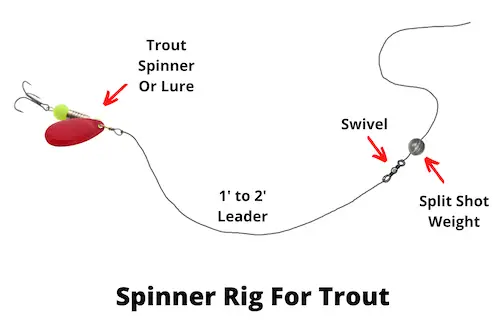The Best Rigs For Trout Fishing In Lakes (With Pictures)
UPDATED 03 NOVEMBER 2023
by Robert Ceran
Thousands of lakes and ponds across North America are stocked with rainbow trout every year, providing a great opportunity for trout fishing in lakes, and one you should make sure to take advantage of.
So what are the best rigs for catching trout in lakes?
While there are many different options to choose from, we’ve distilled the selection down to the top 3 most important trout rigs for fishing in lakes.

In this article we’ll cover the best 3 trout rigs for lakes, and will discuss when and how to use each of them to catch more trout.
How do you rig for trout in a lake?
The three most important trout rigs used for catching trout in lakes are as follows:
- Slip sinker rig
- Slip bobber rig
- Spinner rig
These rigs are the best tools at your disposal for catching trout effectively in lakes. And while there are other rigs that you can also use, it’s best to start by fishing with these three setups, and testing what works best for catching trout in your lake or pond.
The slip sinker and slip bobber rigs are both designed for trout fishing with natural baits, and are best used for stationary fishing, which involves waiting for trout to pass by and take your bait.
The spinner rig, on the other hand, is designed to be fished with artificial lures, and the best way to use it is by moving around and covering lots of water in search of hungry trout.
Now let’s take a closer look at these 3 rigs, and discuss what each of them is best suited for.
Slip sinker rig

This is the most commonly used rig for trout fishing in lakes, and if I had to pick just one rig for this purpose, it would be this one.
The reason why this is such a great rig for catching trout in ponds and lakes is because you can use it to present your bait within 1 to 2 feet off the bottom, which is an ideal depth to target trout in most waters.
In addition to being highly effective, the slip sinker rig is also relatively easy to tie. You start by threading your main line through a 1/8 to 1/4 oz sliding sinker, and then tie the line to a swivel or snap swivel.
Next, tie a 1 to 3 foot long fluorocarbon leader to the swivel, and then tie a size 8 to 14 hook to the other end of the leader.
One thing you need to keep in mind if you want to use the slip sinker rig effectively is that your bait needs to float in the water.
In fact, the bait needs to be buoyant enough to lift the hook up in the water, and you need to make sure that this is actually the case.
If you’re using powerbait for trout, you can easily test this at home by baiting your hook and putting it in a bowl of water.
If it sinks, you can either reduce the size of the hook, or increase the size of the powerbait until it floats.
Another option to make your bait float above the bottom is to use a floating Lindy rig.
On the other hand, if you’re using nightcrawlers or other worms to bait your hook, you can make them float by injecting air into the worm with a worm syringe kit that you can get in most tackle shops.
Slip bobber rig

Unlike the slip sinker rig, which presents your bait close to the bottom, a bobber rig is ideal for presenting your bait higher in the water column.
So if you notice that trout are feeding in the middle or top third of the water column, you can target the right depth by adjusting the length of line between your hook and the slip bobber.
If trout are feeding a few feet under the water surface, you can also use a fixed bobber rig to target them, but if they are in the middle of the water column, a slip bobber rig is the best way to reach them.
In order to set up a slip bobber rig, start by tying a bobber stop on to your main line. Then put a plastic bead on the line, and thread it through the slip bobber.
Underneath the slip bobber, tie your line to a swivel or snap swivel, and add one or more split shot weights between the slip bobber and the swivel.
Next, tie a 1 to 3 foot long fluorocarbon leader to the swivel, and then tie a size 8 to 14 bait hook to the other end of the leader.
Spinner rig

While the previous two rigs are designed to be fished passively with a baited hook, the spinner rig is designed for fishing trout spinners (and other trout lures).
While you can potentially tie your main line directly to a spinner, this is not advisable, since the rotation of the spinner will twist up your line, leading to birds nest formation sooner or later.
Also, if you’re using braid as your main line, you don’t really want to tie that directly to your lure, as it has a higher visibility in water than fluorocarbon, which is enough to spook finicky trout in lakes that get a lot of fishing pressure.
So the best solution to avoid both line twisting and high visibility of your line is to use a 1 to 2 foot long fluorocarbon leader, and tie a swivel between your main line and the leader.
Also, if you’re targeting trout in deeper water (over 5 feet deep), you should add one or more split shot weights just above the swivel, which will enable you to get your lure down to those deep trout.
What is the best rig for trout fishing in lakes?
The best rig for trout fishing in lakes is the slip sinker rig, and if you only learn how to tie one trout rig, this is the one to go for.
The advantage of this rig is that, when set up correctly, it will present your bait floating 1 to 3 feet above the bottom, which is the ideal depth where trout are often found.
That being said, the best rig to choose depends on the conditions you will be fishing in. For example, during the summer trout sometimes feed at the surface.
If this is the case, you’ll probably notice trout jumping and breaking the surface regularly as they feed on insects that fall into the water.
Needless to say, you can’t target these trout with a bottom fishing rig, and instead need to use a bobber rig or a spinner that’s retrieved just under the surface.
And finally, a spinner rig is the best option for covering a lot of water in order to find the best trout fishing spots. The ideal strategy for using it is to keep moving along the shore of the lake, until you find feeding fish.
Best rod and reel setup for trout fishing in lakes
Now let’s talk about the best trout fishing spinning rod setup to use with these rigs.
All three rigs are best fished with a 7 to 8 foot long light or ultralight trout fishing rod, paired with a 1000 to 2000 size spinning reel.
Since stocked trout don’t grow very big in most lakes, you can catch them with ultralight gear, which is a lot of fun, since they put up a good fight on lightweight gear.
However, if you use a 1000 or 1500 size ultralight spinning reel, keep in mind that that may limit your casting distance (due to the smaller size of the spool). So if you need to make longer casts, a 2000 or 2500 size reel may be better.
The best main line to use is 10 to 20 lb test braid or monofilament, tied to a 6 to 10 lb test fluorocarbon leader.
The fluorocarbon leader is important because it has lower visibility underwater compared to other types of fishing line, and so doesn’t spook fish.
A braided main line comes with the advantage of having virtually no stretch, and so provides the highest sensitivity in terms of being able to feel soft trout bites.
If you want to target lake trout specifically, check out our article on lake trout fishing rigs.
